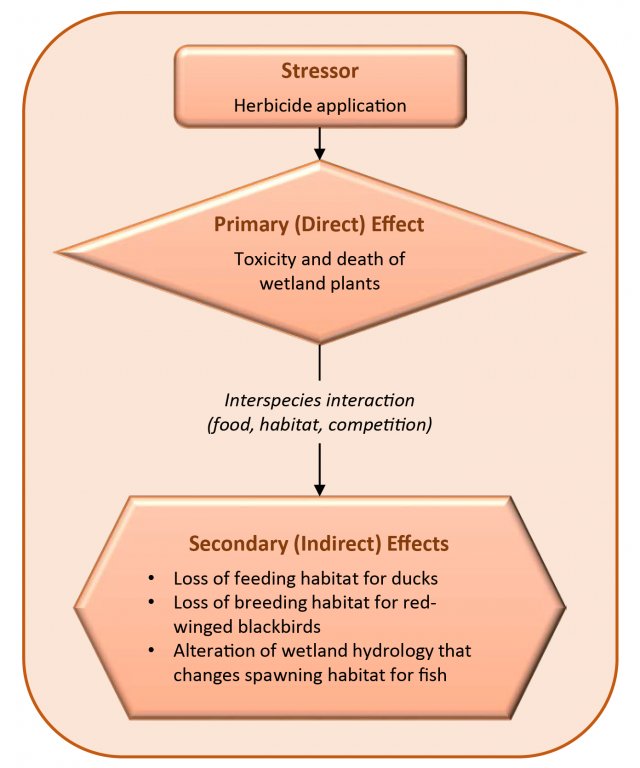EPA EcoBox Tools by Stressors - Stressors in ERA
Planning and Problem Formulation Phase: Identifying Stressors of Concern
During the planning and problem formulation phase, stressors of potential concern are identified and available information on stressors is collected. Key stressor characteristics include:
- Type—chemical, biological, or physical
- Intensity—concentration or magnitude
- Duration—short or long term
- Frequency—one time, episodic, continuous
- Timing—relative to seasons, life cycles
- Scale—extent, spatial heterogeneity
According to U.S. EPA’s Guidelines for Ecological Risk Assessment (1998), determining how a stressor is likely to come in contact with and affect possible receptors forms the basis for developing conceptual models and selecting assessment endpoints. A conceptual model in problem formulation is a written description and visual representation of predicted relationships between ecological entities and the stressors to which they may be exposed (U.S. EPA, 1998).
Analysis Phase: Characterizing Stressor Exposures and Effects to Receptors
During the analysis phase, data are evaluated to determine how exposure to stressors is likely to occur (characterization of exposure) and, given this exposure, the potential and type of ecological effects that can be expected (characterization of ecological effects). Exposure levels are measured or estimated and effects for each stressor/receptor combination are quantified. According to U.S. EPA’s Guidelines for Ecological Risk Assessment (1998), exposure is analyzed by examining the (1) sources of stressors, (2) the distribution of stressors in the environment, (3) the extent of co-occurrence or contact with the stressors, and (4) stressor-response relationships.
Risk Characterization: Quantifying Stressors Effects on Ecological Receptors
The risk characterization quantifies the links between exposure to stressors and effects to ecological receptors—the stressor-response relationships—and characterizes the types, extent, and severity of those risks. According to U.S. EPA’s Guidelines for Ecological Risk Assessment (1998) completing risk characterization allows risk assessors to clarify the relationships between stressors, effects, and ecological entities and to reach conclusions regarding the occurrence of exposure and the adversity of existing or anticipated effects. See the Effects Tool Set for tools for quantifying effects to ecological receptors.
Risk assessors can estimate risk through integration of exposure and stressor-response profiles and determination of ecological adversity. As described in U.S. EPA’s Guidelines for Ecological Risk Assessment (1998), adverse ecological effects represent changes that are undesirable because they alter valued structural or functional attributes of the ecological entities under consideration. Characterizing adversity is important in identifying potential stressors of concern because a stressor may cause adverse effects on one ecosystem component but be neutral or even beneficial to other components. Exposure to a stressor may lead to effects at different levels of biological organization (e.g., individual, population, ecological community). With the presence of multiple stressors exposure is more complex and may result in a cascade of adverse effects. Combined stressors may have effects that are larger than a single stressor and cumulative exposure over time may result in further impacts. According to U.S. EPA’s Guidelines for Ecological Risk Assessment (1998), primary (direct) and secondary (indirect) effects should be considered when characterizing adversity, and sometimes the impact of the secondary effects can outweigh that of the primary effect.
Life stage is important when characterizing adversity. Adverse effects of a particular stressor may be important during one part of an organism’s life cycle (e.g., early development, reproduction). They may result from exposure to a stressor or to the absence of a necessary resource during a critical life stage. For example, if fish are unable to find suitable nesting sites during their reproductive phase, risk is significant even when water quality is high and food sources are abundant.
References
- Suter G. W., I; Gillett, JW; Norton, SB. (1994). Issue paper on characterization of exposure [EPA Report] (pp. 4-1 - 4-64). (EPA/630/R-94/009). Washington, DC: Risk Assessment Forum, U.S. Environmental Protection Agency.
- U.S. EPA. (1991). ECO update, volume 1, number 2 (8 pp, 202 K, About PDF) [EPA Report]. Office of Solid Waste and Emergency Response.
- U.S. EPA. (1992). Framework for ecological risk assessment [EPA Report]. (EPA/630/R-92/001). Washington, DC.
- U.S. EPA. (1993). Wildlife exposure factors handbook [EPA Report]. (EPA/600/R-93/187). Washington, DC: Office of Research and Development.
- U.S. EPA. (1997). Example ecological risk assessments for hypothetical sites (22 pp, 149 K, About PDF) [EPA Report]. Office of Solid Waste and Emergency Response.
- U.S. EPA. (1998). Guidelines for ecological risk assessment [EPA Report]. (EPA/630/R-95/002F). Washington, DC: U.S. Environmental Protection Agency, Risk Assessment Forum.
- U.S. EPA. (2010). Causal Analysis/Diagnosis Decision Information System (CADDIS) [EPA Report]. Washington, DC: U.S. Environmental Protection Agency, Office of Science and Technology.
- U.S. EPA. (2011). Exposure Factors Handbook: 2011 Edition [EPA Report] (pp. 1466). (EPA/600/R-090/052F). U.S. Environmental Protection Agency.
- U.S. EPA Region 5. (2011). Ecological risk assessment; Step 3: Baseline problem formulation.
Tools
Resources that provide information related to stressors in ecological risk assessments are provided below.


